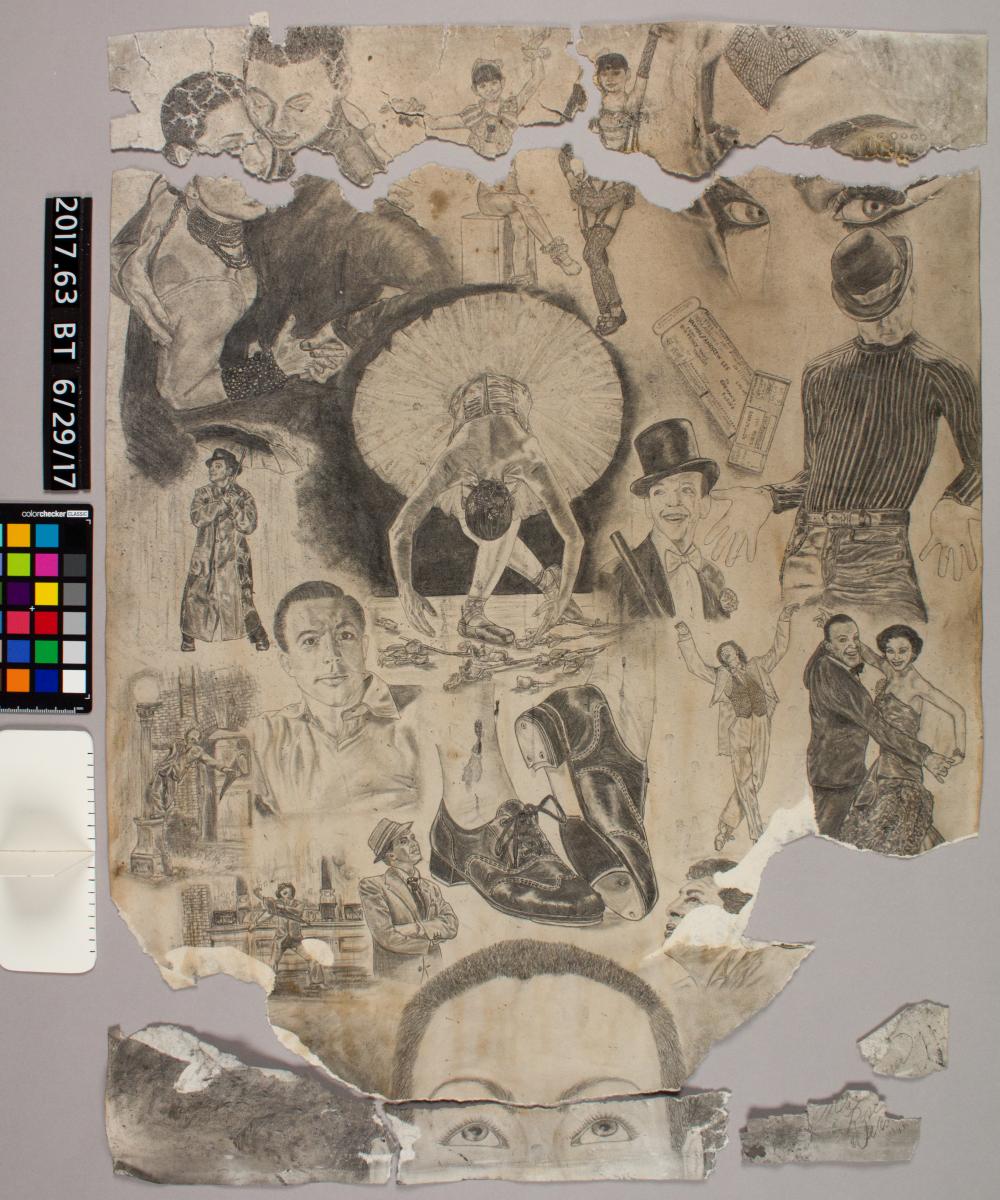When a fire damaged Lila Vamosi’s drawing “The Artist,” she turned to our Gerald Ford Conservation Center to restore it. Although it still shows some scars, they now serve to tell a new story.
In 2017 Lila Vamosi brought in a drawing on paper that had been damaged in a fire. The pencil and charcoal drawing “The Artist” adeptly depicts a collection of vignettes of well-known performers including Fred Astaire, Frank Sinatra, and Gene Kelly. To say the drawing was ‘damaged’ in a fire is a bit of an understatement. When it arrived at the Ford Center the drawing was in approximately eleven pieces; it was hard to get an exact count because multiple sections of the paper had become enmeshed in the plexiglass glazing, which tore away pieces of the drawing as it melted from the intense heat. A thick, dark layer of soot had settled on the front and back of the drawing, which became engrained in the paper fibers. Long drip marks and tidelines from water had mixed with soot and streaked down the drawing.

Before Treatment Photo showing losses, tears and soot damage.
The torn and singed drawing held a lot of sentimental significance for our clients. Lila had drawn the piece as a gift for her future husband, back when they were still dating. Lila’s husband had the framed drawing proudly displayed in his office at work, where the fire occured. Even in it’s broken and sad state it was easy to see the significance.
We knew we could never make the drawing look brand new again, but we came up with a treatment plan to help. First, we removed as much of the drawing attached to the plexiglass as possible using small metal spatulas. Paper loss was inevitable as some areas had become permanentely stuck inside the plexiglass when it resolidified.
The melted frame and plexiglass with fragments of the drawing stuck to and within the plexiglass.
The sections of the drawing were cleaned on the front and back with light vacuuming and sponges to reduce soot and grime. As expected, the paper was VERY dirty from everything it had gone through. Next, the drawing was washed in baths of pH-controlled water to help reduce the engrained soot. This step improved the paper stability by removing harmful products. Washing also changed the overall paper appearance from ‘burnt and cripsy’ to a more typical paper color with renewed texture.
The pieces were then fitted into place like a puzzle and given temporary mends on the front to help hold the entire drawing together.

Temporary mends on the front of the drawing hold the tears together until the paper can be lined.
Finally, the drawing was lined, or adhered, onto one sheet of off-white, Japanese paper to give it a strong but flexible support. The temporary mends were removed and simple paper fills were applied over the areas of paper loss. We often provide aesthetic compensation for damaged artworks, but in this case the client preferred to leave the damages visible to help tell the history of the drawing.

After Treatment Photo showing lined drawing with filled losses.
In the end, this very fire damaged drawing was stabilized through conservation treatment and better preserved for the future. Although the drawing still displays its scars, they help to tell some of its newest story. Since its stay at the Ford Center, the drawing has been reframed and is hanging in Lila’s husband’s office again.


Before (left) and After (right) treatment photo showing losses and fills as well as cleaned paper support.



